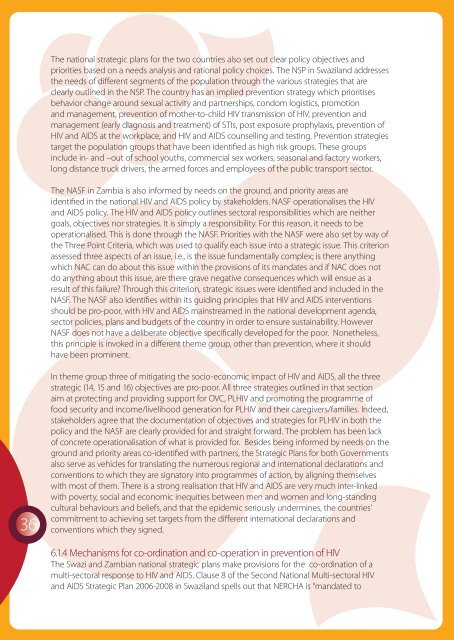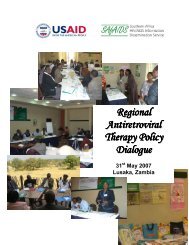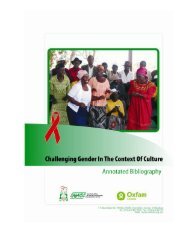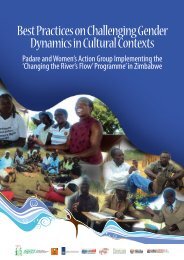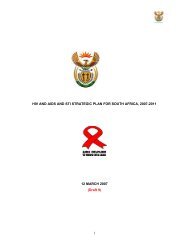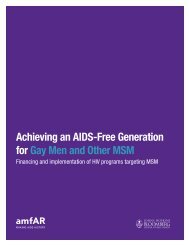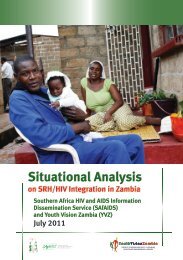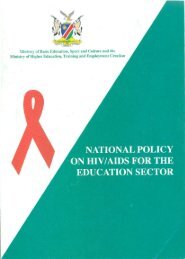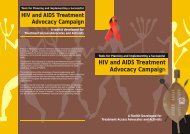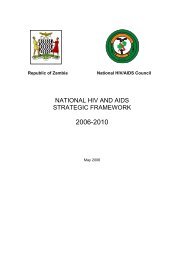Implementation of regional and international HIV prevention - SAfAIDS
Implementation of regional and international HIV prevention - SAfAIDS
Implementation of regional and international HIV prevention - SAfAIDS
- No tags were found...
You also want an ePaper? Increase the reach of your titles
YUMPU automatically turns print PDFs into web optimized ePapers that Google loves.
The national strategic plans for the two countries also set out clear policy objectives <strong>and</strong>priorities based on a needs analysis <strong>and</strong> rational policy choices. The NSP in Swazil<strong>and</strong> addressesthe needs <strong>of</strong> different segments <strong>of</strong> the population through the various strategies that areclearly outlined in the NSP. The country has an implied <strong>prevention</strong> strategy which prioritisesbehavior change around sexual activity <strong>and</strong> partnerships, condom logistics, promotion<strong>and</strong> management, <strong>prevention</strong> <strong>of</strong> mother-to-child <strong>HIV</strong> transmission <strong>of</strong> <strong>HIV</strong>, <strong>prevention</strong> <strong>and</strong>management (early diagnosis <strong>and</strong> treatment) <strong>of</strong> STIs, post exposure prophylaxis, <strong>prevention</strong> <strong>of</strong><strong>HIV</strong> <strong>and</strong> AIDS at the workplace, <strong>and</strong> <strong>HIV</strong> <strong>and</strong> AIDS counselling <strong>and</strong> testing. Prevention strategiestarget the population groups that have been identified as high risk groups. These groupsinclude in- <strong>and</strong> –out <strong>of</strong> school youths, commercial sex workers, seasonal <strong>and</strong> factory workers,long distance truck drivers, the armed forces <strong>and</strong> employees <strong>of</strong> the public transport sector.The NASF in Zambia is also informed by needs on the ground, <strong>and</strong> priority areas areidentified in the national <strong>HIV</strong> <strong>and</strong> AIDS policy by stakeholders. NASF operationalises the <strong>HIV</strong><strong>and</strong> AIDS policy. The <strong>HIV</strong> <strong>and</strong> AIDS policy outlines sectoral responsibilities which are neithergoals, objectives nor strategies. It is simply a responsibility. For this reason, it needs to beoperationalised. This is done through the NASF. Priorities with the NASF were also set by way <strong>of</strong>the Three Point Criteria, which was used to qualify each issue into a strategic issue. This criterionassessed three aspects <strong>of</strong> an issue, i.e., is the issue fundamentally complex; is there anythingwhich NAC can do about this issue within the provisions <strong>of</strong> its m<strong>and</strong>ates <strong>and</strong> if NAC does notdo anything about this issue, are there grave negative consequences which will ensue as aresult <strong>of</strong> this failure? Through this criterion, strategic issues were identified <strong>and</strong> included in theNASF. The NASF also identifies within its guiding principles that <strong>HIV</strong> <strong>and</strong> AIDS interventionsshould be pro-poor, with <strong>HIV</strong> <strong>and</strong> AIDS mainstreamed in the national development agenda,sector policies, plans <strong>and</strong> budgets <strong>of</strong> the country in order to ensure sustainability. HoweverNASF does not have a deliberate objective specifically developed for the poor. Nonetheless,this principle is invoked in a different theme group, other than <strong>prevention</strong>, where it shouldhave been prominent.36In theme group three <strong>of</strong> mitigating the socio-economic impact <strong>of</strong> <strong>HIV</strong> <strong>and</strong> AIDS, all the threestrategic (14, 15 <strong>and</strong> 16) objectives are pro-poor. All three strategies outlined in that sectionaim at protecting <strong>and</strong> providing support for OVC, PL<strong>HIV</strong> <strong>and</strong> promoting the programme <strong>of</strong>food security <strong>and</strong> income/livelihood generation for PL<strong>HIV</strong> <strong>and</strong> their caregivers/families. Indeed,stakeholders agree that the documentation <strong>of</strong> objectives <strong>and</strong> strategies for PL<strong>HIV</strong> in both thepolicy <strong>and</strong> the NASF are clearly provided for <strong>and</strong> straight forward. The problem has been lack<strong>of</strong> concrete operationalisation <strong>of</strong> what is provided for. Besides being informed by needs on theground <strong>and</strong> priority areas co-identified with partners, the Strategic Plans for both Governmentsalso serve as vehicles for translating the numerous <strong>regional</strong> <strong>and</strong> <strong>international</strong> declarations <strong>and</strong>conventions to which they are signatory into programmes <strong>of</strong> action, by aligning themselveswith most <strong>of</strong> them. There is a strong realisation that <strong>HIV</strong> <strong>and</strong> AIDS are very much inter-linkedwith poverty, social <strong>and</strong> economic inequities between men <strong>and</strong> women <strong>and</strong> long-st<strong>and</strong>ingcultural behaviours <strong>and</strong> beliefs, <strong>and</strong> that the epidemic seriously undermines, the countries’commitment to achieving set targets from the different <strong>international</strong> declarations <strong>and</strong>conventions which they signed.6.1.4 Mechanisms for co-ordination <strong>and</strong> co-operation in <strong>prevention</strong> <strong>of</strong> <strong>HIV</strong>The Swazi <strong>and</strong> Zambian national strategic plans make provisions for the co-ordination <strong>of</strong> amulti-sectoral response to <strong>HIV</strong> <strong>and</strong> AIDS. Clause 8 <strong>of</strong> the Second National Multi-sectoral <strong>HIV</strong><strong>and</strong> AIDS Strategic Plan 2006-2008 in Swazil<strong>and</strong> spells out that NERCHA is “m<strong>and</strong>ated to


